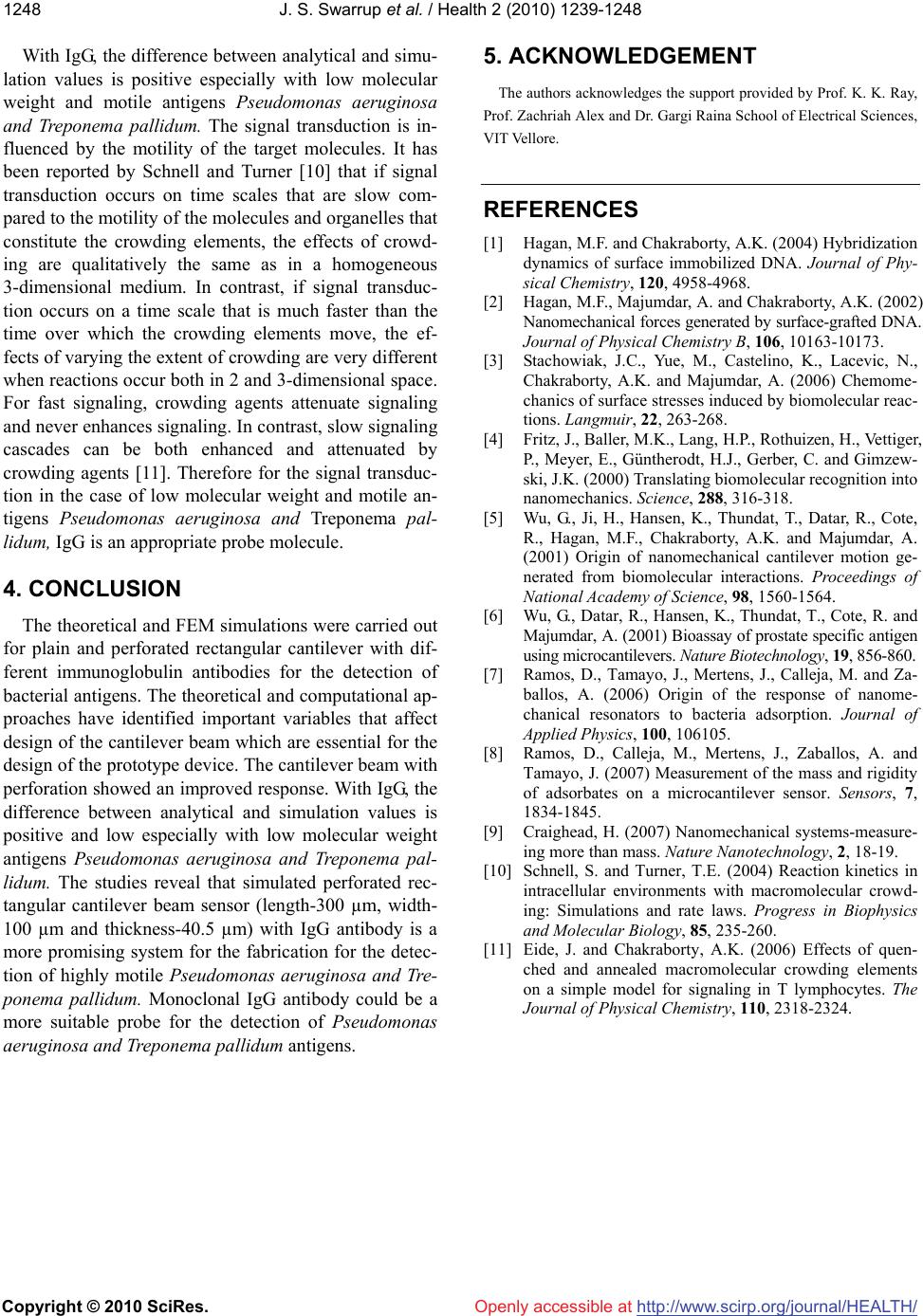
J. S. Swarrup et al. / Health 2 (2010) 1239-1248
Copyright © 2010 SciRes. http://www.scirp.org/journal/HEALTH/
1248
5. ACKNOWLEDGEMENT
With IgG, the difference between analytical and simu-
lation values is positive especially with low molecular
weight and motile antigens Pseudomonas aeruginosa
and Treponema pallidum. The signal transduction is in-
fluenced by the motility of the target molecules. It has
been reported by Schnell and Turner [10] that if signal
transduction occurs on time scales that are slow com-
pared to the motility of the molecules and organelles that
constitute the crowding elements, the effects of crowd-
ing are qualitatively the same as in a homogeneous
3-dimensional medium. In contrast, if signal transduc-
tion occurs on a time scale that is much faster than the
time over which the crowding elements move, the ef-
fects of varying the extent of crowding are very different
when reactions occur both in 2 and 3-dimensional space.
For fast signaling, crowding agents attenuate signaling
and never enhances signaling. In contrast, slow signaling
cascades can be both enhanced and attenuated by
crowding agents [11]. Therefore for the signal transduc-
tion in the case of low molecular weight and motile an-
tigens Pseudomonas aeruginosa and Tr ep on ema pal-
lidum, IgG is an appropriate probe molecule.
The authors acknowledges the support provided by Prof. K. K. Ray,
Prof. Zachriah Alex and Dr. Gargi Raina School of Electrical Sciences,
V
IT Vellore.
REFERENCES
[1] Hagan, M.F. and Chakraborty, A.K. (2004) Hybridization
dynamics of surface immobilized DNA. Journal of Phy-
sical Chemistry, 120, 4958-4968.
[2] Hagan, M.F., Majumdar, A. and Chakraborty, A.K. (2002)
Nanomechanical forces generated by surface-grafted DNA.
Journal of Physical Chemistry B, 106, 10163-10173.
[3] Stachowiak, J.C., Yue, M., Castelino, K., Lacevic, N.,
Chakraborty, A.K. and Majumdar, A. (2006) Chemome-
chanics of surface stresses induced by biomolecular reac-
tions. Langmuir, 22, 263-268.
[4] Fritz, J., Baller, M.K., Lang, H.P., Rothuizen, H., Vettiger,
P., Meyer, E., Güntherodt, H.J., Gerber, C. and Gimzew-
ski, J.K. (2000) Translating biomolecular recognition into
nanomechanics. Science, 288, 316-318.
[5] Wu, G., Ji, H., Hansen, K., Thundat, T., Datar, R., Cote,
R., Hagan, M.F., Chakraborty, A.K. and Majumdar, A.
(2001) Origin of nanomechanical cantilever motion ge-
nerated from biomolecular interactions. Proceedings of
National Academy of Science, 98, 1560-1564.
4. CONCLUSION
[6] Wu, G., Datar, R., Hansen, K., Thundat, T., Cote, R. and
Majumdar, A. (2001) Bioassay of prostate specific antigen
using microcantilevers. Nature Biotechnology, 19, 856-860.
The theoretical and FEM simulations were carried out
for plain and perforated rectangular cantilever with dif-
ferent immunoglobulin antibodies for the detection of
bacterial antigens. The theoretical and computational ap-
proaches have identified important variables that affect
design of the cantilever beam which are essential for the
design of the prototype device. The cantilever beam with
perforation showed an improved response. With IgG, the
difference between analytical and simulation values is
positive and low especially with low molecular weight
antigens Pseudomonas aeruginosa and Treponema pal-
lidum. The studies reveal that simulated perforated rec-
tangular cantilever beam sensor (length-300 µm, width-
100 µm and thickness-40.5 µm) with IgG antibody is a
more promising system for the fabrication for the detec-
tion of highly motile Pseudomonas aeruginosa and Tre-
ponema pallidum. Monoclonal IgG antibody could be a
more suitable probe for the detection of Pseudomonas
aeruginosa and Treponema pallidum antigens.
[7] Ramos, D., Tamayo, J., Mertens, J., Calleja, M. and Za-
ballos, A. (2006) Origin of the response of nanome-
chanical resonators to bacteria adsorption. Journal of
Applied Physics, 100, 106105.
[8] Ramos, D., Calleja, M., Mertens, J., Zaballos, A. and
Tamayo, J. (2007) Measurement of the mass and rigidity
of adsorbates on a microcantilever sensor. Sensors, 7,
1834-1845.
[9] Craighead, H. (2007) Nanomechanical systems-measure-
ing more than mass. Nature Nanotechnology, 2, 18-19.
[10] Schnell, S. and Turner, T.E. (2004) Reaction kinetics in
intracellular environments with macromolecular crowd-
ing: Simulations and rate laws. Progress in Biophysics
and Molecular Biology, 85, 235-260.
[11] Eide, J. and Chakraborty, A.K. (2006) Effects of quen-
ched and annealed macromolecular crowding elements
on a simple model for signaling in T lymphocytes. The
Journal of Physical Chemistry, 110, 2318-2324.
Openly accessible at